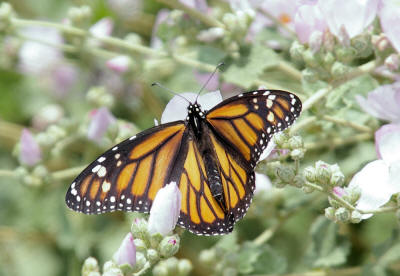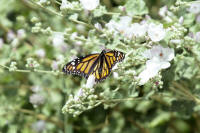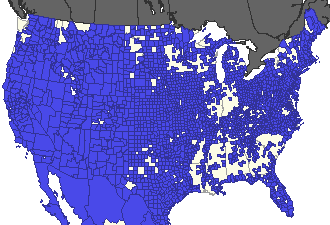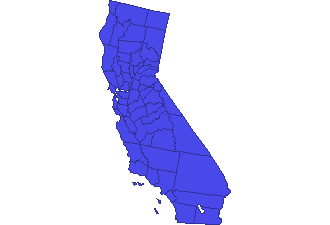|
Taxonomic Hierarchy |
Photo |
|
Kingdom: |
Animalia -- animal |
|
Phylum: |
Arthropoda -- arthropods |
|
Subphylum: |
Hexapoda -- hexapods |
|
Class: |
hexapoda -- insects |
|
Subclass: |
Pterygota -- iwinged insects |
|
Infraclass: |
Neoptera -- modern, wing-folding insects |
|
Order: |
Lepidoptera -- butterflies, moths |
|
Superfamily: |
Papilionoidea -- butterflies |
|
Family: |
Nymphalidae -- admirals, anglewings,
brush-footed butterflies |
|
Subfamily: |
Danainae -- Milkweed Butterflies |
|
Genus: |
Danaus |
|
Species: |
Danaus plexippus |
|
 |
|
United States Range Map |
|
California Range Map |
|
Adult Sexes
Similar |
 |
 |
|
|
|
|
|
|
Identification: |
|
Life history:
|
|
Upperside of male is bright orange with wide black borders
and black
veins;
hindwing has a patch of scent scales. Upperside of
female is orange-brown with wide black borders and blurred
black veins. Both sexes have white spots on borders and
apex. The Viceroy butterfly (Limenitis archippus) is a
Mullerian mimic; it has similar coloration and is also
distasteful. |
|
Adults warm up by basking dorsally (with their wings open
and toward the sun). Females lay eggs singly under the host
leaves; caterpillars eat leaves and flowers. Adults make
massive migrations from August-October, flying thousands of
miles south to hibernate along the California coast and in
central Mexico. A few
overwinter along the Gulf coast or south Atlantic
coast. Along the way, Monarchs stop to feed on flower nectar
and to roost together at night. At the Mexico wintering
sites, butterflies roost in trees and form huge aggregations
that may have millions of individuals. During the winter the
butterflies may take moisture and flower nectar during warm
days. Most have mated before they leave for the north in the
spring, and females lay eggs along the way. Residents of
tropical areas do not migrate but appear to make altitude
changes during the dry season. |
|
Flight: |
|
Wing Span: |
|
In North America during spring and summer there may be 1-3
broods in the north and 4-6 broods in the south. May breed
all year in Florida, South Texas, and southeastern
California. |
|
3 3/8 - 4 7/8 inches (8.6 - 12.4 cm). |
|
Caterpillar Hosts: |
|
Adult Food: |
|
Milkweeds including common milkweed (Asclepias syriaca),
swamp milkweed (A. incarnata), and showy milkweed (A.
speciosa); and milkweed vine in the tropics. Most milkweeds
contain cardiac glycosides which are stored in the bodies of
both the caterpillar and adult. These poisons are
distasteful and emetic to birds and other vertebrate
predators. After tasting a Monarch, a predator might
associate the bright warning colors of the adult or
caterpillar with an unpleasant meal, and avoid Monarchs in
the future. |
|
Nectar from all milkweeds. Early in the season before
milkweeds bloom, Monarchs visit a variety of flowers
including dogbane, lilac, red clover, lantana, and thistles.
In the fall adults visit composites including goldenrods,
blazing stars, ironweed, and tickseed sunflower. |
|
Habitat: |
|
Season: |
|
Many open habitats including fields, meadows, weedy areas,
marshes, and roadsides. |
|
March through fall in eastern US. All year in tropics. |
|
Remarks: |
|
Conservation: |
|
|
|
Conservation: Overwintering sites in California and
Mexico should be protected and conserved.
NatureServe Global Status:
G5 - Demonstrably secure globally, though it may be quite
rare in parts of its range, especially at the periphery.
Management needs: Develop conservation and
management plans for all wintering sites, migration
corridors, and principal breeding areas.
|
|
Sources used to
Construct this Page: |
|
|
|
|
|
|
NatureServe is a non-profit conservation
organization. Global ranks indicate the rarity of a species at a
global scale. Species may be fairly common globally but imperiled
locally. Global ranks have the following meaning:
- G1 - Critically Imperiled - At very high risk of extinction
due to extreme rarity (often 5 or fewer populations), very steep
declines, or other factors.
- G2 - Imperiled - At high risk of extinction due to very
restricted range, very few populations (often 20 or fewer),
steep declines, or other factors.
- G3 - Vulnerable - At moderate risk of extinction due to a
restricted range, relatively few populations (often 80 or
fewer), recent and widespread declines, or other factors.
- G4 - Apparently Secure - Uncommon but not rare; some cause
for long-term concern due to declines or other factors.
- G5 - Secure - Common; widespread and abundant.
- * ? or Q = status unknown or uncertain
|




